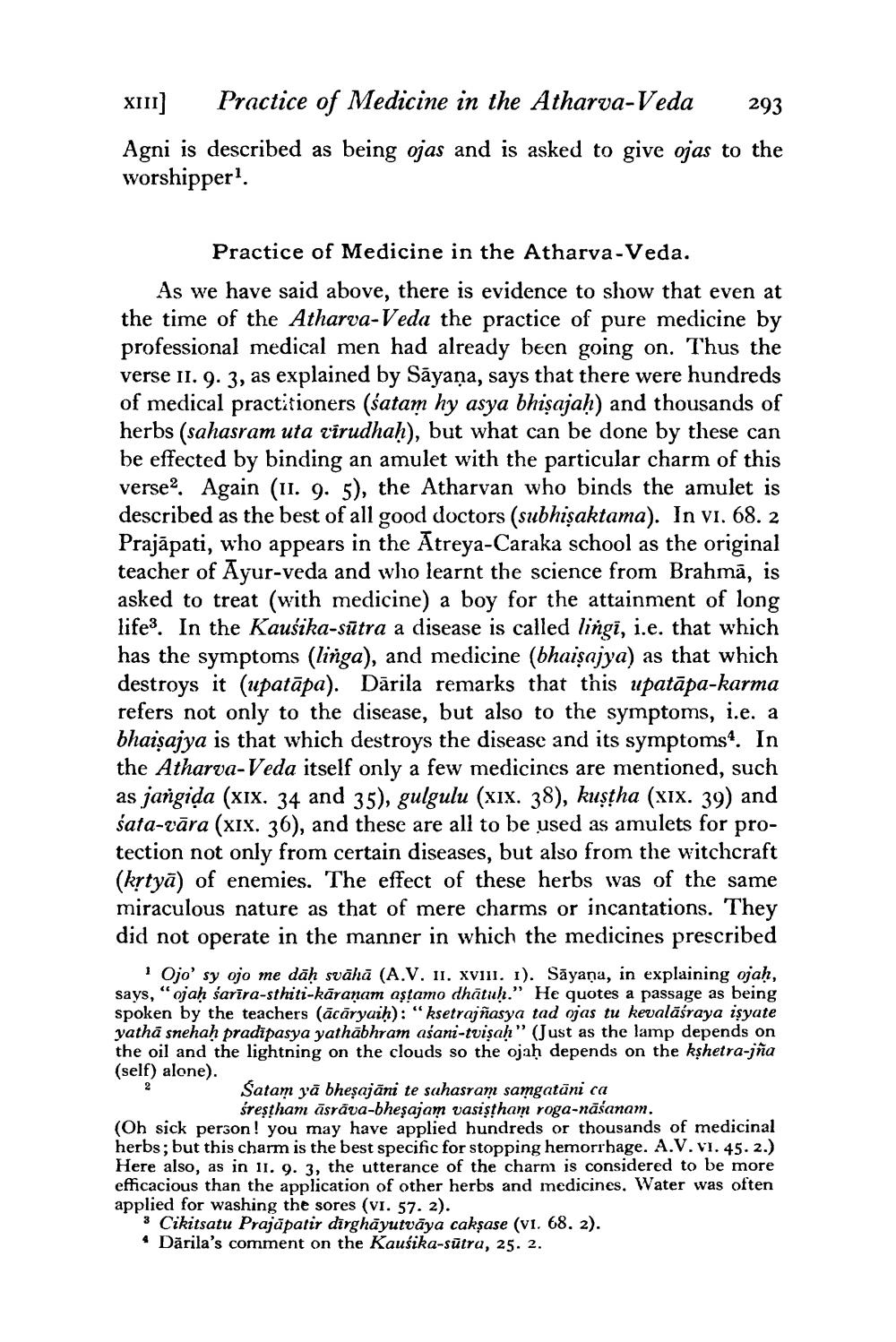________________
XIII]
Practice of Medicine in the Atharva-Veda
293
Agni is described as being ojas and is asked to give ojas to the worshipper1.
Practice of Medicine in the Atharva-Veda.
As we have said above, there is evidence to show that even at
the time of the Atharva-Veda the practice of pure medicine by professional medical men had already been going on. Thus the verse II. 9. 3, as explained by Sāyaṇa, says that there were hundreds of medical practitioners (satam hy asya bhiṣajah) and thousands of herbs (sahasram uta virudhaḥ), but what can be done by these can be effected by binding an amulet with the particular charm of this verse2. Again (II. 9. 5), the Atharvan who binds the amulet is described as the best of all good doctors (subhiṣaktama). In vi. 68. 2 Prajapati, who appears in the Atreya-Caraka school as the original teacher of Ayur-veda and who learnt the science from Brahmā, is asked to treat (with medicine) a boy for the attainment of long life. In the Kausika-sūtra a disease is called lingi, i.e. that which has the symptoms (linga), and medicine (bhaiṣajya) as that which destroys it (upatāpa). Dārila remarks that this upatāpa-karma refers not only to the disease, but also to the symptoms, i.e. a bhaiṣajya is that which destroys the disease and its symptoms1. In the Atharva-Veda itself only a few medicines are mentioned, such as jangida (XIX. 34 and 35), gulgulu (XIX. 38), kuṣṭha (XIX. 39) and śata-vāra (XIX. 36), and these are all to be used as amulets for protection not only from certain diseases, but also from the witchcraft (kṛtyā) of enemies. The effect of these herbs was of the same miraculous nature as that of mere charms or incantations. They did not operate in the manner in which the medicines prescribed
1 Ojo' sy ojo me dāḥ svāhā (A.V. II. XVIII. 1). Sāyaṇa, in explaining ojaḥ, says, "ojaḥ sarira-sthiti-kāraṇam aṣṭamo dhatuh." He quotes a passage as being spoken by the teachers (ācāryaiḥ): "ksetrajñasya tad ojas tu kevalasraya iṣyate yatha snehaḥ pradipasya yathabhram asani-tviṣaḥ" (Just as the lamp depends on the oil and the lightning on the clouds so the ojah depends on the kshetra-jña (self) alone).
Satam ya bheṣajāni te sahasram samgatāni ca
śreṣṭham asrāva-bheṣajam vasistham roga-nāśanam.
(Oh sick person! you may have applied hundreds or thousands of medicinal herbs; but this charm is the best specific for stopping hemorrhage. A.V. vi. 45. 2.) Here also, as in 11. 9. 3, the utterance of the charm is considered to be more efficacious than the application of other herbs and medicines. Water was often applied for washing the sores (VI. 57. 2).
3 Cikitsatu Prajāpatir dīrghāyutvāya cakṣase (v1. 68. 2). 4 Därila's comment on the Kausika-sutra, 25. 2.




